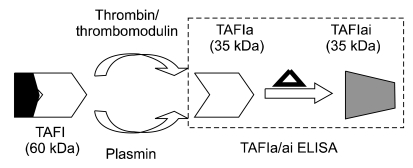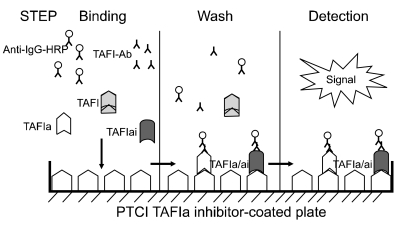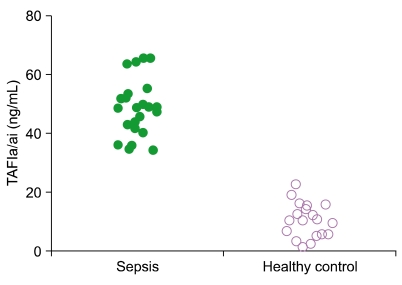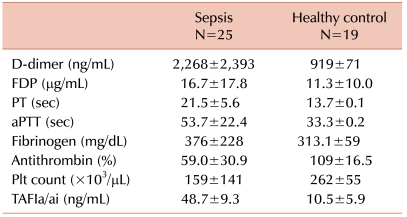1. Anas AA, Wiersinga WJ, de Vos AF, van der Poll T. Recent insights into the pathogenesis of bacterial sepsis. Neth J Med. 2010; 68:147–152. PMID:
20421654.
2. Pierrakos C, Vincent JL. Sepsis biomarkers: a review. Crit Care. 2010; 14:R15. PMID:
20144219.

3. Levi M. The coagulant response in sepsis and inflammation. Hamostaseologie. 2010; 30:10–12. 14–16. PMID:
20162247.

4. Blackwell TS, Christman JW. Sepsis and cytokines: current status. Br J Anaesth. 1996; 77:110–117. PMID:
8703620.

5. Faust SN, Heyderman RS, Levin M. Coagulation in severe sepsis: a central role for thrombomodulin and activated protein C. Crit Care Med. 2001; 29(7 Suppl):S62–S67. PMID:
11445736.

6. Sawamura A, Hayakawa M, Gando S, et al. Disseminated intravascular coagulation with a fibrinolytic phenotype at an early phase of trauma predicts mortality. Thromb Res. 2009; 124:608–613. PMID:
19660788.

7. Esmon CT, Fukudome K, Mather T, et al. Inflammation, sepsis, and coagulation. Haematologica. 1999; 84:254–259. PMID:
10189392.
8. Mackman N. The many faces of tissue factor. J Thromb Haemost. 2009; 7(Suppl 1):136–139. PMID:
19630786.

9. Redlitz A, Tan AK, Eaton DL, Plow EF. Plasma carboxypeptidases as regulators of the plasminogen system. J Clin Invest. 1995; 96:2534–2538. PMID:
7593646.

10. Bajzar L, Manuel R, Nesheim ME. Purification and characterization of TAFI, a thrombin-activable fibrinolysis inhibitor. J Biol Chem. 1995; 270:14477–14484. PMID:
7782309.

11. Bajzar L, Morser J, Nesheim M. TAFI, or plasma procarboxypeptidase B, couples the coagulation and fibrinolytic cascades through the thrombin-thrombomodulin complex. J Biol Chem. 1996; 271:16603–16608. PMID:
8663147.

12. Wang W, Boffa MB, Bajzar L, Walker JB, Nesheim ME. A study of the mechanism of inhibition of fibrinolysis by activated thrombin-activable fibrinolysis inhibitor. J Biol Chem. 1998; 273:27176–27181. PMID:
9765237.

13. Hendriks D, Wang W, Scharpé S, Lommaert MP, van Sande M. Purification and characterization of a new arginine carboxypeptidase in human serum. Biochim Biophys Acta. 1990; 1034:86–92. PMID:
2328266.

14. Marx PF, Dawson PE, Bouma BN, Meijers JC. Plasmin-mediated activation and inactivation of thrombin-activatable fibrinolysis inhibitor. Biochemistry. 2002; 41:6688–6696. PMID:
12022872.

15. Hulme JP, An SSA. Detecting activated thrombin activatable fibrinolysis inhibitor (TAFIa) and inactivated TAFIa (TAFIai) in normal and hemophilia a plasmas. Bull Korean Chem Soc. 2009; 30:77–82.
16. van Tilburg NH, Rosendaal FR, Bertina RM. Thrombin activatable fibrinolysis inhibitor and the risk for deep vein thrombosis. Blood. 2000; 95:2855–2859. PMID:
10779431.

17. Meijers JC, Oudijk EJ, Mosnier LO, et al. Reduced activity of TAFI (thrombin-activatable fibrinolysis inhibitor) in acute promyelocytic leukaemia. Br J Haematol. 2000; 108:518–523. PMID:
10759708.

18. Silveira A, Schatteman K, Goossens F, et al. Plasma procarboxypeptidase U in men with symptomatic coronary artery disease. Thromb Haemost. 2000; 84:364–368. PMID:
11019956.

19. Watanabe R, Wada H, Watanabe Y, et al. Activity and antigen levels of thrombin-activatable fibrinolysis inhibitor in plasma of patients with disseminated intravascular coagulation. Thromb Res. 2001; 104:1–6. PMID:
11583733.

20. Koster T, Blann AD, Briët E, Vandenbroucke JP, Rosendaal FR. Role of clotting factor VIII in effect of von Willebrand factor on occurrence of deep-vein thrombosis. Lancet. 1995; 345:152–155. PMID:
7823669.

21. Meijers JC, Tekelenburg WL, Bouma BN, Bertina RM, Rosendaal FR. High levels of coagulation factor XI as a risk factor for venous thrombosis. N Engl J Med. 2000; 342:696–701. PMID:
10706899.

22. Binette TM, Taylor FB Jr, Peer G, Bajzar L. Thrombin-thrombomodulin connects coagulation and fibrinolysis: more than an in vitro phenomenon. Blood. 2007; 110:3168–3175. PMID:
17644733.

23. Antovic J, Schulman S, Eelde A, Blombäck M. Total thrombin-activatable fibrinolysis inhibitor (TAFI) antigen and pro-TAFI in patients with haemophilia A. Haemophilia. 2001; 7:557–560. PMID:
11851753.

24. Antovic JP, Schulman S, An SS, Greenfield RS, Blombäck M. Does an enzyme other than thrombin contribute to unexpected changes in the levels of the different forms of thrombin activatable fibrinolysis inhibitor in patients with hemophilia A, hemophilia B and von Willebrand disease? Scand J Clin Lab Invest. 2004; 64:745–751. PMID:
15719893.

25. Leung LL, Nishimura T, Myles T. Regulation of tissue inflammation by thrombin-activatable carboxypeptidase B (or TAFI). Adv Exp Med Biol. 2008; 632:61–69. PMID:
19025114.

26. Hoekstra J, Guimarães AH, Leebeek FW, et al. Impaired fibrinolysis as a risk factor for Budd-Chiari syndrome. Blood. 2010; 115:388–395. PMID:
19965669.

27. Ermantas N, Guldiken S, Demir M, Tugrul A. Thrombin-activatable fibrinolysis inhibitor (TAFI) antigen and activity assay in patients with primary hypothyroidism. Clin Appl Thromb Hemost. 2010; 16:568–573. PMID:
19959491.

28. Tàssies D, Roqué M, Monteagudo J, et al. Thrombin-activatable fibrinolysis inhibitor genetic polymorphisms as markers of the type of acute coronary syndrome. Thromb Res. 2009; 124:614–618. PMID:
19699511.

29. Peters MJ, Nurmohamed MT, van Eijk IC, Verkleij CJ, Marx PF. Thrombin-activatable fibrinolysis inhibitor and its relation with inflammation in rheumatoid arthritis. Ann Rheum Dis. 2009; 68:1232–1233. PMID:
19525410.








 PDF
PDF ePub
ePub Citation
Citation Print
Print



 XML Download
XML Download